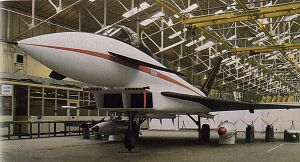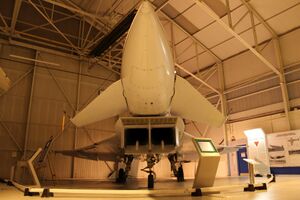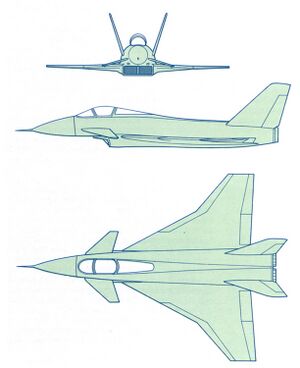FAv-30
| FAv-30 | |
|---|---|

| |
| A pre-production FAv-30 aircraft with a simulated loadout | |
| Role | Air superiority fighter |
| National origin | |
| Manufacturer | Trinovantanske Luftfartssystemer |
| First flight | October 8th, 1975 |
| Introduction | March 12th, 1978 |
| Status | In service |
| Primary user | Trinovantan Air Force |
| Produced | 1977-present |
The FAv-30 is a twin-engine all-weather air superiority fighter designed and produced by Trinovantanske Luftfartssystemer. It entered service in 1978 during the Fifth Ostlander-Trinovantan War, where it was one of the most effective combat aircraft of the Trinovantan military. It remains the premier air superiority aircraft in the Trinovantan Air Force to this day.
Development
In 1966, the Trinovantan Air Force issued a requirement for a new air superiority aircraft to exceed the capabilities of the Navy’s FAv-25. Initial development used the Air Force’s previous FAv-23 interceptor as a basis with an enlarged airframe, more powerful engines, and improved avionics to achieve performance at least equal to the Navy’s FAv-25. However, reports from the ongoing Omandan Continental War about the capabilities of Transnapastaini aircraft prompted major requirement changes in 1969.
These changes were radically different from the original requirements, which were based mostly on airframe speed, climb rate, and maneuverability. Now, there was an additional focus on the development of avionics and the ability to carry more missiles. Of particular concern was extending the range in which the aircraft’s on-board radar could search for and track targets and developing Look-down/shoot-down capabilities.
New missiles were to be developed for the proposed aircraft, to make use of the advances in technology. These projects were to be started concurrently with the changes to the new air superiority fighter project, though the start of many were delayed until the capabilities of the aircraft and its new systems were considered more concrete. Eventually, these new weapons programs resulted in the GLkLø-12E7, GLkLø-30 and GLkLø-32 missiles.
The final proposal for the Air Force was radically different from previous aircraft in terms of its design and capabilities, possessing a number of design choices and equipment that were completely new to Trinovantan aircraft. The advanced nature of this aircraft delayed its final development considerably. A full scale prototype was only produced by mid-1975, amid rapidly rising tensions between Trinovantum and Ostlichtor. Its first flight was only scant months before the onset of the Fifth Ostlander-Trinovantan War.
Ostlichtor had been pursuing increased relations with Transnapastain during the leadup to the war. Included in this was the purchase of new aircraft and weapons. This potential threat posed resulted in an increase in the priority of the development and production of the FAv-30. It had been predicted that the aircraft would not enter service until 1980 at the earliest. However, rushed development during the war saw the aircraft accepted into limited service in 1978, with pre-production aircraft being used for familiarization. Several of the more advanced secondary systems that weren’t considered critical to the FAv-30’s combat capabilities were added in the later E1 and E2 variants.
Design
The FAv-30 possesses a number of highly advanced characteristics for its era. It was one of the first combat aircraft in the world to intentionally use a relaxed stability design. An aircraft with relaxed stability is more responsive when engaging in hard maneuvering. The normal downsides to a relaxed stability design, being a significant increase in the difficultly of controlling the aircraft, were reduced via the use of another novel technology: a digital fly-by-wire system. The FAv-30 was the first production combat aircraft to use an all-digital fly by wire control system, with the technology previously being pioneered on a FAv-22 testbed aircraft in the early 1970s. The computer controlled flight system allows for the undesirable characteristics of a relaxed stability design to be mitigated with automatic trimming of the control surfaces in real time by the flight computer.
The FAv-30 makes use of a cranked delta wing design with canards for increased pitch control. The twin V tail “ruddervators” contribute to poth pitch and yaw control, with roll control being done primarily through the aircraft’s ailerons. The canard and delta wing combination was unconventional, but not unheard of. In combat jet aircraft this configuration was pioneered by Svenska Flygförsvar of Svenska with the AJ 37 aircraft, though this design was not a relaxed stability design and made use of a manual, hydraulically assisted control system.
Propulsion is provided by two FEA F-390/90-95 turbofan engines which provide up to 95 kN of thrust each with the afterburner engaged. These engines were powerful for the weight and size class, and gave the FAv-30 a thrust:weight ratio of 0.95 with a full fuel and combat load. The engines suffered from the accelerated development of the FAv-30 having several faults during its service in the Fifth Ostlander-Trinovantan War. These engines would continue to have reliability issues after the war until ultimately being replaced by the FEA F-382/88-100 turbofans in the E2 variant.
The engines are fed from a split intake ramp on the underside of the fuselage. A splitter plate is used to regulate airflow through the intakes.
The FAv-30 uses the LkRdSr-63 pulse-doppler passive electronically scanned array RADAR. This RADAR features monopulse encoding for compatibility with the GLkLø-30 missile and has look-down/shoot-down capabilities. It is capable of detecting aircraft at altitudes as low as treetop level and from beyond visual ranges. Against an aircraft with a 1 m2 radar cross section, roughly analogous to a single seat fighter aircraft, the LkRdSr-63 is capable of detecting it at a range of approximately 150 km.
Navigation is aided by an onboard inertial navigation system, as well as a tactical air navigation system. The FAv-30 possesses a central digital computer that manages its weapons, navigation equipment, communications equipment, and sensors. This computer processes the myriad of information that these systems produce and outputs relevant data to the cockpit’s heads up display. This allows the pilot to focus more time on the forward display and less on the cockpit instruments, aiding in situational awareness.
As an air superiority aircraft, the FAv-30 can carry a variety of advanced air to air weapons. It possesses 9 hardpoints, of which only 3 hardpoints are rated to carry weapons other than anti-aircraft weapons. The aircraft will usually carry a combination of GLkLø-12E7 all-aspect infrared guided short range missiles and GLkLø-30 semi-active radar homing long range missiles with the central and underwing hardpoints carrying additional weapons or jettisonable fuel tanks as needed. The FAv-30 is also equipped with a single 30mm LkMk-10E4 revolver cannon with 120 rounds of stowed ammunition. This is enough for a little over 5 seconds of continuous firing.
Deployment of the weapons is handled by an automatic weapons management system which feeds data to the aircraft’s heads up display and is operated primarily via controls on the flight stick and throttle. This semi-automated system significantly reduces the workload to deploy and control the aircraft’s armament, a job that was considered significant enough to require a second operator on several previous aircraft. This system is capable of automatically locking targets when in close-quarters combat, to further reduce the workload on the pilot in a situation where they need to focus as much as possible on flying.
Operational History
The FAv-30 reached initial operational status in 1978, two years into the Fifth Ostlander-Trinovantan War. It was produced in limited numbers during the war, where it was sent to front-line squadrons to counter Ostlichtor’s advanced imported Transnapastaini aircraft. Its advanced weapons and long range capabilities gave it a distinct edge over Ostlichtor’s Luftstreitkräfte, whose aircraft doctrine still focused on within visual range combat. Over the course of the war, the FAv-30 achieved a 65:2 kill:loss ratio. The top scoring FAv-30 ace, Asbjørn Haavik, scored 13 kills with this model of aircraft during the conflict.
Variants
Military Variants
- FAv-30 - Initial Service Model
- FOp-30 - Two seat training model
- FAv-30E1 - Replacement of older IR MAWS with UV MAWS, addition of ECM-resistant radio
- FAv-30E2 - Improved F-382/88-100 engine, addition of nose-mounted IRST, replacement of leading-edge slats with a more efficient design.
- FAv-30E3 - Addition of two outboard wing hardpoints for increased ordinance variability, addition of a fuselage mounting point for targeting/navigation pods, night-vision-device compliant HUD/cockpit, improved RADAR with superior multi-target tracking and reliability/ease-of-maintenance, minor-redesign of semi-conformal points to accept new GLkLø-44 missile.
- FOp-30E3 - Two seat training model of the E3 variant.
- FAv-30E4 - Replacement of INS with a combined GPS/INS system, improved EWS.
- FAv-30E5 - New AESA RADAR, integration of helmet visual cueing system, addition of mounting points for 2400 kg conformal fuel tanks.
Nonmilitary Variants
- TLfS AFCST - The Advanced Flight Control Systems Testbed was the 8th FAv-30 produced in the original production batch. It was repurchased by Trinovantanske Luftfartssystemer after the Fifth Ostlander-Trinovantan War as a private testbed for experimental technologies in 1988.
Operators
Specifications (FAv-30E3)
General characteristics
- Crew: 1
- Length: 14.8 m (48 ft 7 in)
- Wingspan: 12.2 m (40 ft 0 in)
- Height: 5.0 m (16 ft 5 in)
- Wing area: 52 m2 (560 sq ft)
- Empty weight: 14,000 kg (30,865 lb)
- Gross weight: 19,680 kg (43,387 lb)
- Max takeoff weight: 28,000 kg (61,729 lb)
- Internal fuel capacity: 4,500 kg (9,900 lb)
- Powerplant: 2 × FEL F-382/88-100 afterburning turbofan engine, 73 kN (16,000 lbf) thrust each dry, 100 kN (22,000 lbf) with afterburner
Performance
- Maximum speed: Mach 2.4
- Mach 1.1 at sea level
- Combat range: 160 km (99 mi; 86 nmi) CAP (2x GLkLø-12, 4x GLkLø-30, 3x drop tanks, 180 min on station)
- Ferry range: 3,000 km (1,864 mi; 1,620 nmi) +
- Service ceiling: 20,000 m (66,000 ft)
- Rate of climb: 250 m/s (49,000 ft/min)
- Wing loading: 378.5 kg/m2 (77.5 lb/sq ft)
- Thrust/weight: 1.04
Armament
- Guns: 1x 30mm LkMk-10E4 revolver cannon (120 rounds)
- Hardpoints: Up to 12 with a combined capacity of 7050 kg
- 2x Wingtip hardpoints capable of carrying
- 4x Semi-recessed fuselage hardpoints capable of carrying
- 2x Under-wing hardpoints rated for 1000 kg
- 2x Under-wing hardpoints rated for 500 kg
- 1x Offset fuselage hardpoint for targeting pods
- 1x Center-line hardpoint rated for 2250 kg
Avionics
- LkRdSr-63 Multi-Mode PESA RADAR
- LkRaId-82 Aircraft IFF system
- LkKoMt-28 Missile Warning System
- LkLeMt-44 Chaff/Flare dispenser
- LkRaMt-83 wingtip electronic countermeasures pod
See Also
Aircraft of comparable role, configuration, and era:


